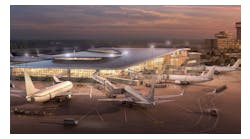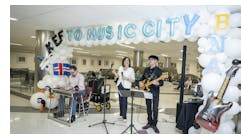Angela Gittens began her tenure as director general of Airports Council International (ACI) in 2008. Before coming to ACI, she served as airport CEO for Miami International Airport and Atlanta’s Hartsfield-Jackson International Airport, along with a term as deputy director at San Francisco International Airport.
Gittens served as vice president of airport business services for Kansas City-based HNTB Corp., where she led the firm’s practice in airport business and strategic planning. And as vice president at Atlanta-based TBI Airport Management, she oversaw London Luton Airport’s transition to private ownership.
Gittens is a fellow of the Royal Aeronautical Society and has served on numerous aviation industry boards and committees, including the FAA Management Advisory Committee, the FAA Research, Engineering and Development Committee, the National Civil Aviation Review Commission (the Mineta Commission), the executive committee of the Transportation Research Board, the Airport Cooperative Research Program Oversight Committee and the board of directors of JetBlue Airways.
Global airport passenger traffic grew by 6.1 percent in 2015. What do you attribute this growth to?
It was very interesting. We almost saw a disengagement of air traffic demand from other factors that were always related in the past. We saw two main things in 2015. One, the emerging economies that had been driving growth in aviation slowed down greatly. Every BRIC country except for India slowed in 2015. Two, we saw developed economies come back.
There were big traffic increases in North America and Europe, which was somewhat of a reversal of trends that had been omnipresent in the past 10 years. We had geopolitical issues and health scares in 2015, but through it all, passenger traffic continued to grow.
Even though China has slowed down, it still has a big population and many people moving into the middle class. It’s slower, but it’s still growth. Even Brazil, with all its problems, still has people moving into the middle class, so that’s still growth. Overall, it was a mixed bag in 2015, but air service demand on the passenger side remained resilient.
In 2015, there seemed to be an increased interest in the passenger experience with airlines. What has ACI done to work with members on improving the passenger experience in airports?
We’ve done several things. We have the ACI Airport Service Quality (ASQ) program, which allows us to conduct a standardized survey around the world.
We’ve been doing it for 10 years and we’ve gotten a lot of good data on what matters most to passengers. There are common threads and we give that data back to airport subscribers. We also provide guidance to airports on the topics that matter most. Airports can look at their scores and draw their own conclusions.
We look at things like wayfinding, concessions, cleanliness and other features that affect the passenger experience. We know what matters most for passengers and we share that with airports. For example, Wi-Fi access wasn’t even in the top 10 items 10 years ago; now it’s in the top three.
How do you think the ASQ program has helped airports around the world step up their game when it comes to the passenger experience?
We have 319 airports involved in ASQ. The program gives them actual data, rather than anecdotes, complaint letters or items from a suggestion box. They get information from passengers on the day that they travel, when the experience is still fresh in their minds.
You can’t hide from this data. Passengers are telling airports what they think of various features and giving them overall ratings. Based on that rating and specific features and comments, you can start correlating what is most important to your passengers. The survey is telling airports the facts.
The survey gives airports solid data and they are increasingly using it for overall performance, driving toward common goals that are objective. The information comes from travelers who have no reason to lie or have a bias one way or another.
And the data can be used to benchmark yourself against other airports based on size and region. It gives airports a rich internal barometer. Using the data, you can make actual improvements that will have an impact on passengers.
There’s a need to develop leaders in the industry. ACI created the Global ACI-ICAO Airport Management Professional Accreditation Programme. Why did you think this program was necessary?
It has been a roaring success. We started having our graduation ceremony at our annual general assembly. These people are paraded in front of airport CEOs from around the world.
We have heard from our CEOs that it has made a difference in the performance and behavior of graduates. We also have heard how valuable it is from our students. They are networking with airport professionals from around the world and they can’t get that any other way. To have relationships with airport professionals in other countries really opens their eyes and minds to become more innovative and strategic. They continue to stay in touch with each other and issues.
We will start a reaccreditation program next year. Our graduates have to keep up their skills. Like lawyers and doctors, you have to do continuing education. Our program will involve research, writing a paper and presenting it at a conference.
Airports don’t operate in a vacuum. How does ACI work with other organizations like IATA and ICAO for balanced aviation policies?
ACI moved to Montreal so we’d have closer engagement with ICAO and it’s been a resounding success. Our subject matter experts have daily contact with their experts.
ICAO just approved major overhaul of Annex 14 [which covers airport design and operations]. And to a large extent, this was a project that was promoted and worked on by ACI and its members. I don’t know when the last overhaul had been. And it would not have happened without our close engagement with ICAO. That sense of partnership has allowed us to be seen as credible.
Overall, the industry has worked together to get things done. We have a lot of common interests. When [Director-General] Tony Tyler came to IATA, his approach was collaboration and partnership where we have common interests.
For example, we have a memorandum of understanding with IATA on the Smart Security project, which looks at current and future approaches to airport checkpoint screening. We’re working to develop a risk-based approach to security. Look at the U.S. and its TSA PreCheck program; we want to see things like that in other countries. We all care about efficiency and a good passenger experience.
The role of technology at airports continues to grow, both on the operations and customer service sides. How is ACI working with members and companies to promote technology?
An example is ACI’s beacon task force. Airports and airlines have installed beacons that keep track of how passengers move. We have a task force to provide guidance for airports, including how to procure and use these systems effectively, enhance the passenger experience and provide more data and information.
North America is developing an app where passengers can deal with several airports at once. ACI-NA is partnering with tech companies to provide services to members and help them better use technology.
The world conference is coming up in September in Montreal. What are some highlights that attendees can look forward to?
It’s very interesting because our event is at the same time as the ICAO assembly. We will have ministers and heads of civil aviation from 191 countries in town at the same time. We’ll have airport CEOs and their ministers of transportation and civil aviation all together. It will be a great opportunity for attendees to look at policy issues coming out of ICAO.




